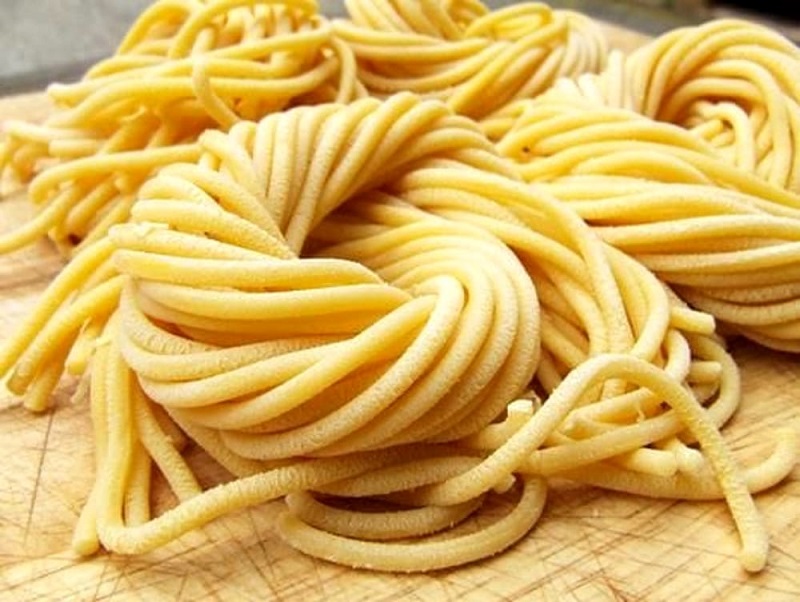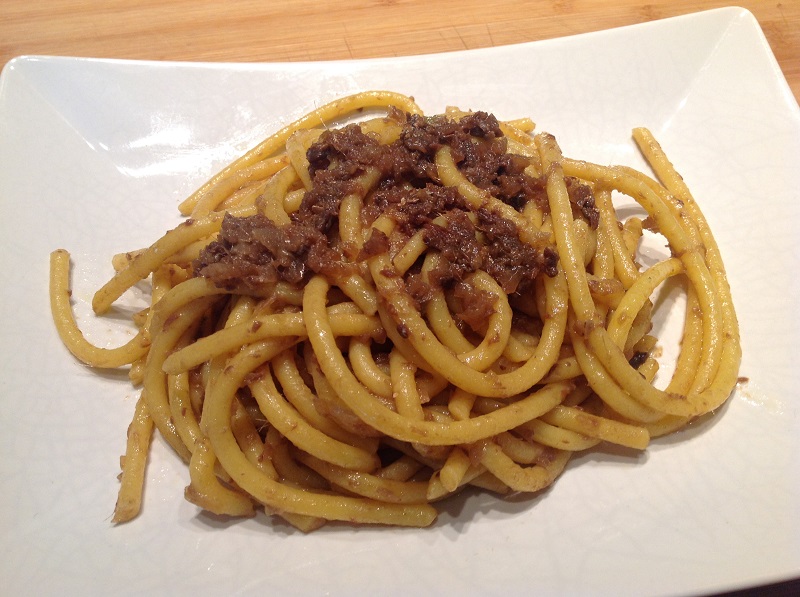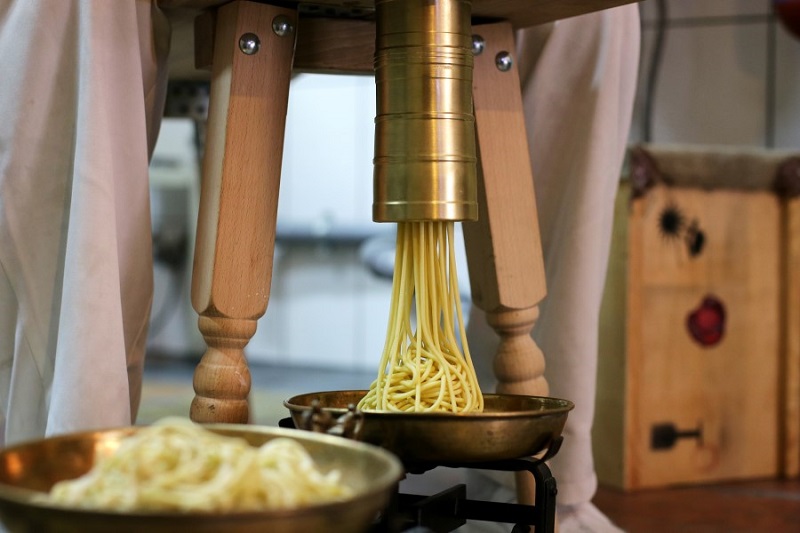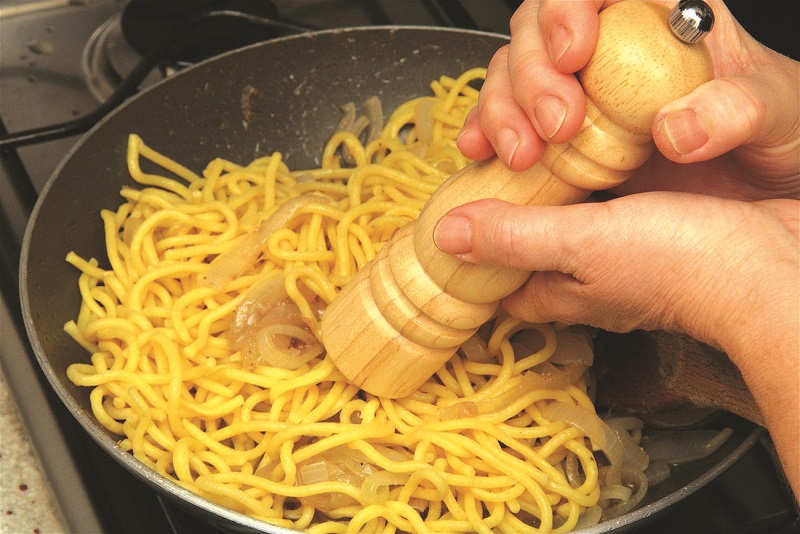When we talk about bigoli in salsa, our mouths are watering at the mere thought of tasting this typical dish of traditional Venetian cuisine. It is impossible to visit Venice and not try it at least once. It is an absolute must on the list of things to do in the lagoon capital, just like visiting St Mark's Square or crossing the Rialto Bridge.
History of bigoli in salsa

In traditional Venetian cuisine, bigoli in salsa are among the best known and most popular first courses. Because of their anchovy-based sauce, bigoli were usually eaten on eve days such as Ash Wednesday, Good Friday and 24 December, when the Catholic religion required that they be eaten lightly. Today, however, bigoli in salsa can be prepared and eaten at any time of the year, without waiting for special occasions.
Before describing the preparation of this recipe, it is worth taking a leap into history, or rather, into legend. Yes, because when we talk about this first course, we cannot fail to mention something about the long spaghetti with a rough and porous surface used for this recipe and which are traditionally prepared with a press.
Like all legends, this one should be taken as a tale and not as documented truth.
It is said that spaghetti arrived in Venice, and therefore in Europe, from China, thanks to Marco Polo. It seems that one day the famous traveller, while in Catai, sent a servant to a village to get provisions and that the servant saw women preparing long strands of pasta which were then cooked in boiling water and then seasoned. He had the ingredients and preparation of this curious food revealed to him and reported back to Marco Polo. When he returned home, he decided to introduce spaghetti to the whole of Venice.
This is not the only tradition surrounding this recipe. There are those who claim that the actual recipe for bigoli in salsa is an invention of the Jews living in the Venice ghetto.
It is not known whether this is true or not, what is certain is that in Venice these spaghetti are called bigoli and that this dish is among the best known of traditional Venetian cuisine.
The recipe for bigoli in salsa

Here is the recipe for bigoli in sauce taken from the book "A tavola con i dogi - Storia e ricette della grande tradizione veneziana" by Pino Agostini and Alvise Zorzi.
Ingredients
To prepare the bigoli you need
- 300 g wholemeal flour (or white flour)
- 3 whole eggs
- 3 pinches of salt
- water (as much as needed)
For the sauce:
- 1 glass of extra virgin olive oil
- 4 salted anchovies
- 1 half-sized white onion
- freshly ground pepper
Preparation time :
1 hour
Preparation of bigoli

Preparation at home requires the use of a press and the creation of a mixture of flour, eggs, water and salt, which is then pressed against a perforated copper disc. These are then cut into long, thick spaghetti which, according to Venetian tradition, should be dark because they are made from whole wheat flour. Don't be surprised to find some light ones too. They may not be the traditional ones, but they are still delicious even if made with white flour. They do however become darker once on the plate and dressed with the sauce.
The bigoli on the market, whether light or dark, can be fresh or dried. While the pasta may have different characteristics, as we have seen, this is not the case for the sauce, which in the original version is made strictly with anchovies or sardines, white onions and extra virgin olive oil.

To prepare the bigoli:
Place the flour on a pastry board forming the typical fountain and put the eggs and salt inside.
With the help of a fork, incorporate the flour and eggs along with a few tablespoons of water until the consistency is solid. At this point, the dough is worked by hand, turning it over and over and pressing it with the palms until it becomes a homogeneous and very elastic mass.
The dough is left to rest for about 20 minutes, wrapped in a lightly floured cloth. It is then cut into two parts and passed through the press, thus obtaining the bigoli which are collected in a bowl sprinkled with flour so that they do not stick together. The bigoli are placed on a dish towel and left to rest while the sauce is prepared and the water comes to the boil.
Clean the anchovies by removing the head, the bones and the scales (if necessary) and wash them under running water to remove excess salt. Then cut them into small pieces.
Cut the onion into thin slices and put it, together with the anchovies, into a small pan in which the olive oil has been heated. Before the onion turns golden, stop the cooking with two tablespoons of water or white wine, lower the heat and cover the pot. Let it simmer, stirring occasionally, until the sauce is well blended.
In the meantime, boil the water, already lightly salted, to cook the bigoli (bear in mind the rule of one litre of water for every 100 grams of pasta. Do not add too much salt because the sauce is already very salty).
When the water comes to the boil you can put down the bigoli, taking care to unravel them well with a large fork so that they do not stick together.
Leave the pot without the lid in order to better monitor the cooking, remembering to stir from time to time with the fork. There is no precise cooking time for bigoli because it depends on the consistency you prefer and the thickness of the ingredients used. The ideal is to cook them "al dente" and in the case of this recipe about 5-8 minutes, that is, until the pasta is cooked, but keeps its harder core inside.
Then drain the bigoli quickly so that they retain some of their cooking water in their heap, pour them into a serving bowl and dress them with the sauce. It is better to serve them on previously heated plates. The bigoli in salsa are now ready to be enjoyed, as no other additions are required.
There are also different versions of bigoli in sauce.
As already mentioned, bigoli can be dark or light. As far as the sauce is concerned, however, the variations are minimal. Nowadays, instead of salted anchovies, it is possible to use anchovy fillets in oil, ready to use. Certainly the most interesting of the variants is the Jewish one, which uses a very finely chopped garlic instead of onion.
This is a special Venetian recipe for bigoli in sauce, to be enjoyed with a good glass of wine (we recommend Garganega dei Colli Berici or Tocai Italico dei Colli Euganei) and possibly with a view of the marvels of Venice.










Lascia un commento